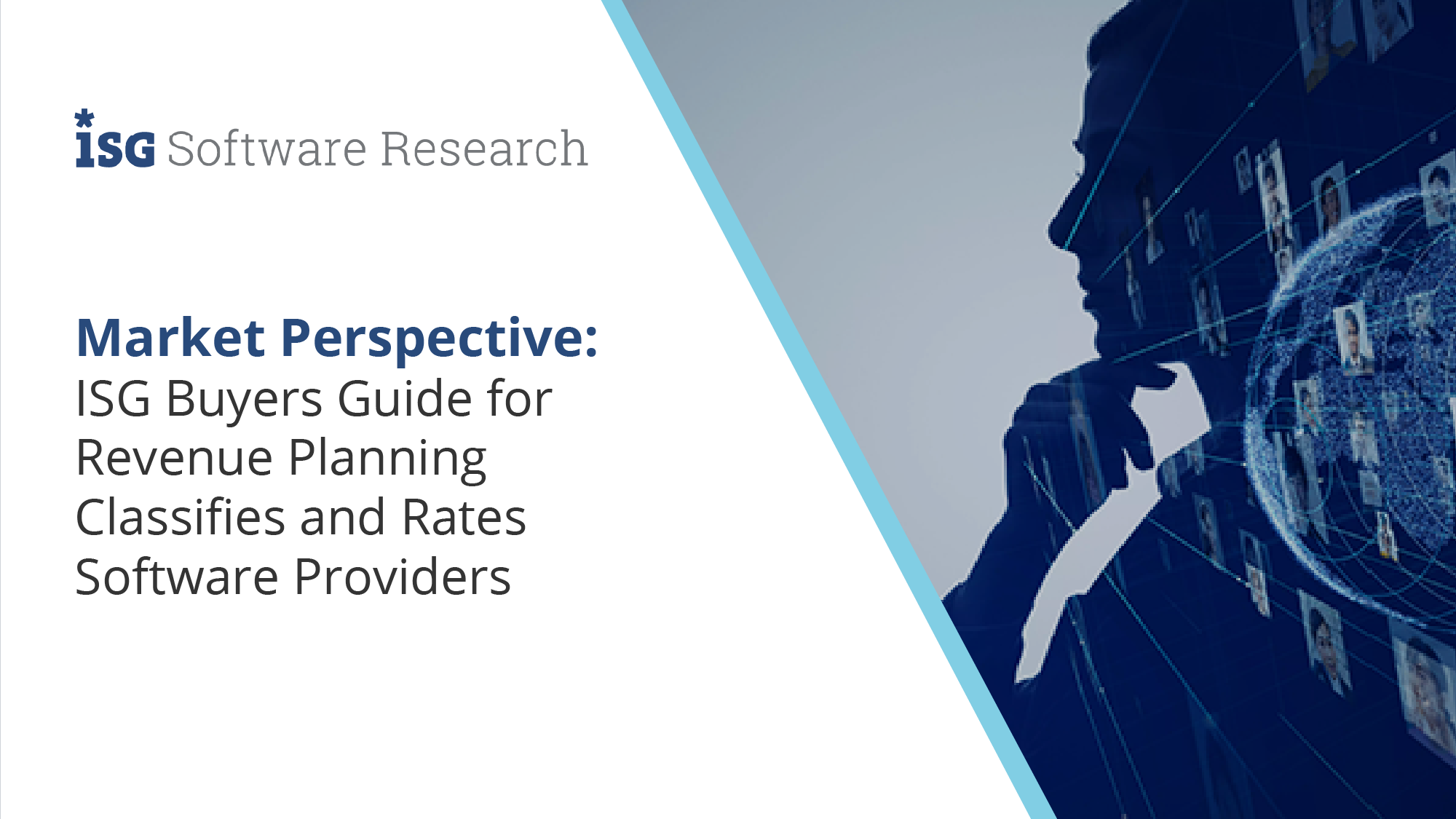Play audio
ISG Research is happy to share insights gleaned from our latest Buyers Guide, an assessment of how well software providers’ offerings meet buyers’ requirements. The Revenue Planning: ISG Research Buyers Guide is the distillation of a year of market and product research by ISG Research.
Planning software is designed to refine and expedite the budgeting process, boosting the productivity of the financial planning and analysis (FP&A) group, while also enabling  executives to set objectives and allocate resources in alignment with an enterprise’s strategy. The primary objective is to generate the revenue needed to fund the resources necessary to achieve short- and long-term goals. Until recently, this top-line number was simply the sales target for the coming period. However, in many businesses, there has been a shift in focus from sales to revenue. This, combined with the increasing sophistication of available software, has made projecting revenue an essential part of the planning process.
executives to set objectives and allocate resources in alignment with an enterprise’s strategy. The primary objective is to generate the revenue needed to fund the resources necessary to achieve short- and long-term goals. Until recently, this top-line number was simply the sales target for the coming period. However, in many businesses, there has been a shift in focus from sales to revenue. This, combined with the increasing sophistication of available software, has made projecting revenue an essential part of the planning process.
ISG Research defines revenue planning as a holistic approach to detailed forecasting of revenue sources and associated sales operations elements, including territory and quota planning, sales capacity planning, incentive compensation and demand planning for revenue.
The term “revenue” is replacing the once ubiquitous “sales” in planning because, in many enterprises, the sales department is being superseded by revenue teams.  These revenue teams support a broader set of traditional sales functions that include not only gaining new customers but also focusing on customer retention, expansion and cross-sell to existing customers. ISG Research asserts that by 2026, over one-half of enterprises will establish a Chief Revenue Officer leadership role, focusing on all channels and sources of revenue, not just direct sales.
These revenue teams support a broader set of traditional sales functions that include not only gaining new customers but also focusing on customer retention, expansion and cross-sell to existing customers. ISG Research asserts that by 2026, over one-half of enterprises will establish a Chief Revenue Officer leadership role, focusing on all channels and sources of revenue, not just direct sales.
The shift from a one-time sale approach to one that includes recurring revenue, such as subscriptions, has increased the importance of accurately forecasting these multiple streams. As enterprises embrace additional sales channels, whether through more typical indirect sales from partners or new digital selling channels like e-commerce, revenue management will require a higher degree of alignment and coordination. This highlights the importance of aligning all elements necessary for generating revenue, including the parallel efforts in managing territories, setting quotas and designing compensation plans that reflect the rising importance of self-service buying.
Managing the gamut of sales and revenue operations requires well-designed and continuously optimized territories and accounts aligned with quotas that are designed to achieve an enterprise’s full revenue potential. Territories can be based not only on geographies but also on a variety of alternate drivers, leading to virtual territories that meet current needs. Quotas need to be linked to both overall organizational objectives and product and service category targets. With the advent of self-service and digital channels, and as customers engage across multiple channels for a single purchase, both quotas and territories need to ensure sales individuals are not penalized or disincentivized. This foundation must be established through modeling and planning that provide the analytics and metrics necessary to guide revenue leadership and operations for the coming month, quarter, year and beyond. To remain flexible and responsive to market conditions, enterprises should incorporate the concept of continuous revenue performance monitoring into their planning process, adjusting territories, quotas and incentives based on data-driven insights and forecasts.
Using analytics and data from operations and planning is essential for designing revenue-related compensation plans that utilize commissions and incentives to influence and align behavior and priorities. To optimize revenue performance, enterprises must design and apply incentives that motivate those supporting revenue generation to reach their targets. To evaluate the effectiveness of compensation plans and incentives, revenue leadership needs tools to assess the relationship between plans, targets and actual performance. Comparing compensation and incentive plans among all revenue personnel and other parts of the enterprise can help managers determine whether what they provide is appropriate. Goals and objectives must be defined, established, tracked and linked to incentives and rewards to guide revenue performance. Moreover, enterprises need to know whether their compensation is competitive in their market.
Enterprises that adopt a revenue focus find that they need dedicated software to handle the complexities associated with this strategy. Using spreadsheets to manage revenue planning, operations and performance is ineffective and can be problematic when trying to achieve optimal outcomes. Spreadsheets are two-dimensional constructs, while planning, analyzing and reporting revenue are inherently multidimensional. These dimensions include customers, geographies, product and currencies, among others. Spreadsheets are not well equipped to manage the data needed to plan multiple revenue channels or the varying types of buying and selling channels that must be measured against goals and targets. They typically produce scattered and inconsistent information, which serves as a major impediment to planning revenue. Spreadsheets also cannot scale well to support an enterprise as it grows.
The shift to a revenue focus has significant implications for finance departments, largely due to the fundamental change to revenue recognition accounting principles that took place in the late 2010s. Whereas closing a one-time sale is almost always contemporaneous with the receipt of cash and the ability to report the full amount of that sale, subscriptions and recurring revenue business models pose complications for planners. They need to accurately determine when sales commissions on closed business are due, when cash is received and when revenue can be recognized for financial reporting purposes. Spreadsheets might be adequate for revenue planning in static environments and simple commercial structures, but they pose burdens on FP&A and sales operations groups in real-world situations. These burdens translate to a substantial amount of unproductive time required to make changes and adjustments, as well as delays between when decision-makers ask questions and when they get answers.
This shift has expanded the scope of forecasting, planning, analyzing and reporting capabilities related to revenue by providers of business planning software, most of which have included in-depth revenue planning features and functions in their application. Artificial Intelligence (AI) built into revenue planning functionality will have a growing impact on how enterprises operate in coming years. Although software providers will be increasing their applications’ capabilities, adoption will be measured. We assert that through 2026, fewer than 1 in 5 enterprises will utilize AI and data to align incentives that ensure the right balance between direct, indirect partner and digital commerce channels to achieve revenue targets. Those that are in this vanguard will likely outperform their peers.
The ISG Buyers Guide™ for Revenue Planning evaluates products based on our comprehensive assessment of how well the software facilitates the creation and update of sales forecasts, supports territory and quota planning as well as sales capacity planning, its ability to calculate and update incentive compensation, and how well it supports demand planning for revenue. The guide also examines the extent to which the software provides embedded revenue analytics that improve performance, the depth and breadth of specific embedded AI to facilitate and improve the timeliness and accuracy of revenue planning, and how it supports executives, participants and administrators in the process. Additionally, it evaluates how the software facilitates advanced planning techniques, whether it offers out of the box reporting and dashboards, and the impact of provider investments in this area.
To focus on the specific needs of revenue planners, this guide excludes our evaluation of the providers’ capabilities for integrated business planning, other departmental and functional planning, and enterprise budgeting. The applications evaluated in this revenue planning buyers guide are those that broadly facilitate business planning. We therefore do not include software providers that do not have support for financial planning and, thus, did not consider providers that focus mainly or exclusively on revenue planning.
This research evaluates the following software providers that offer products that address key elements of revenue planning as we define it: Anaplan, Board, IBM, Jedox, OneStream, Oracle, Pigment, Planful, Prophix, SAP, Vena Solutions, Wolters Kluwer and Workday.
This research-based index evaluates the full business and information technology value of revenue planning software offerings. We encourage you to learn more about our Buyers Guide and its effectiveness as a provider selection and RFI/RFP tool.
We urge organizations to do a thorough job of evaluating revenue planning offerings in this Buyers Guide as both the results of our in-depth analysis of these software providers and as an evaluation methodology. The Buyers Guide can be used to evaluate existing suppliers, plus provides evaluation criteria for new projects. Using it can shorten the cycle time for an RFP and the definition of an RFI.
The Buyers Guide for Revenue Planning in 2024 finds OneStream first on the list, followed by Anaplan and Oracle.
Software providers that rated in the top three of any category ﹘ including the product and customer experience dimensions ﹘ earn the designation of Leader.
The Leaders in Product Experience are:
- OneStream.
- Oracle.
- Anaplan.
The Leaders in Customer Experience are:
- Anaplan.
- OneStream.
- Board.
The Leaders across any of the seven categories are:
- OneStream, which has achieved this rating in six of the seven categories.
- Anaplan and Oracle in five categories.
- IBM and SAP in two categories.
- Board in one category.

The overall performance chart provides a visual representation of how providers rate across product and customer experience. Software providers with products scoring higher in a weighted rating of the five product experience categories place farther to the right. The combination of ratings for the two customer experience categories determines their placement on the vertical axis. As a result, providers that place closer to the upper-right are “exemplary” and rated higher than those closer to the lower-left and identified as providers of “merit.” Software providers that excelled at customer experience over product experience have an “assurance” rating, and those excelling instead in product experience have an “innovative” rating.
Note that close provider scores should not be taken to imply that the packages evaluated are functionally identical or equally well-suited for use by every enterprise or process. Although there is a high degree of commonality in how organizations handle revenue planning, there are many idiosyncrasies and differences that can make one provider’s offering a better fit than another.
ISG Research has made every effort to encompass in this Buyers Guide the overall product and customer experience from our revenue planning blueprint, which we believe reflects what a well-crafted RFP should contain. Even so, there may be additional areas that affect which software provider and products best fit an enterprise’s particular requirements. Therefore, while this research is complete as it stands, utilizing it in your own organizational context is critical to ensure that products deliver the highest level of support for your projects.
You can find more details on our community as well as on our expertise in the research for this Buyers Guide.
Fill out the form to continue reading.

